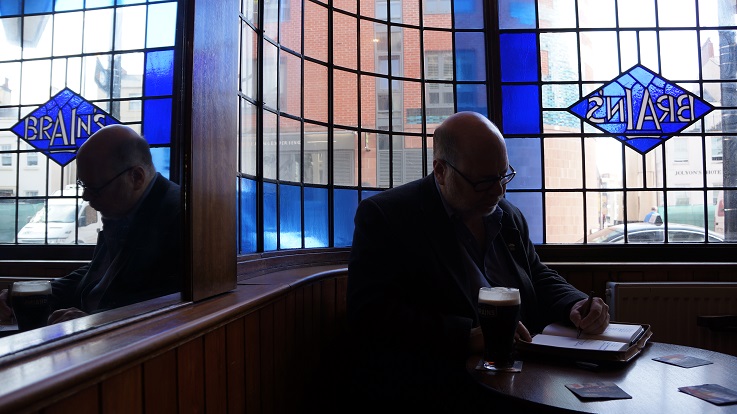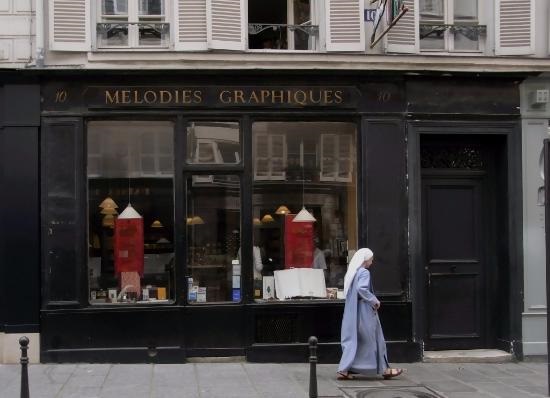 |
85. Rue du Papier, Paris
My visit to Paris lasted only four days. I stayed in the same hotel Ms Keogh had discovered for us on our one and only visit the year before, the Select Hôtel Rive Gauche on Place de la Sorbonne. We had planned to come back. I returned alone hoping her ghost would join me there. She did not.
The afternoons and evenings were spent with good friends, drinking and talking, but the mornings I had to myself. I reserved one morning to a search for paper. I didn’t need paper. There was an overabundant supply of fine writing paper filling my desk at home. Notwithstanding my plenteous stock, my favorite sources for rare and beautiful papers have “folded their tents and silently stole away” years ago as the age of epistolography has been ceded to emails and text messaging. And yet, I had a premonition that in Europe, with its longer history, they had not entirely forgotten the precious practices of centuries. In places where civilizations have persisted for millennia, the old is not automatically deemed unattractive and worthless. There I would find a holdout, a store that sold beautiful writing papers.
The night before I sallied forth, I made preparations for my exploration, trying to find clues where best to search. I mucked about in Google with the disadvantage of not having French. I had expected to find this Holy Grail in the Latin Quarter where I was staying. However, the most promising shop was Calligrane, and it was located across the river in Le Marais. The marsh?
I memorized the map. It would be easy. I didn't need a map to find my way to Notre Dame. I could follow any street from the hotel that inclined down to the river and I would see the cathedral.
It was another summer-like day in Paris the next morning, even though it was October. My visit had been blessed with perfect weather. Once I was confronting the famous façade of the cathedral, I called to mind the map. Passing along the north side of the cathedral, there was the Pont Saint-Louis, not that I remembered the name of the bridge. I have a bad memory for names, especially foreign ones. The map in my head was a physical model. What the map didn't tell me is there would be a jazz pianist playing an upright piano and accompanied by a saxophonist. They were terrific, playing the old standards I favored. It put me into a positive mood, certain that whatever I discovered would be well worth a walk in this direction.
I didn't need to remember the name of the connecting street (rue Jean du Bellay). It was a short street across the island and it was easy to find the next bridge (Pont Louis Philippe) which took me to the block on which my destination waited, rue du Pont Louis Philippe.
Calligrane! It was closed. Nevertheless, I had found myself on the street Parisians call "rue du Papier". I had discovered the mother lode for paper, a dream come true. Here was a collection of shops specializing in fine papers and dispersed among these shops were galleries of art. Of the several shops, I will restrict myself to reporting just two, in part because the others were closed or commonplace.
I eventually did get inside Calligrane, a stationer and gallery. Writing paper and paper for art was being sold, but they also exhibited prints and sculptures made of paper. It should not be missed. Clean and bright, with things framed by space, it was a presentation place. A room of right angles, uncluttered and neatly arranged, you could have been in a small gallery of a contemporary museum, which is in part what Calligrane is. Represented on the walls, shelves, and on a long table were new ideas in prints and novel uses of paper to form sculptures. The artists exhibited in this shop were innovative, renewing the ways paper can be used attractively.
However marvelous I found Calligrane to be, the shop that appealed to me the most, which I found as a consequence of not being able to first visit Calligrane, was Mélodies Graphiques.

Mélodies Graphiques is just a few doors up from
Calligrane. I stepped through the late 19th
century storefront into a shop that could have just as
easily been fictional. It was more a shop imagined
than real, having the appearance of an alchemist’s
study. It looked cluttered at first, but that was
because every inch was occupied with diverse products.
Shelves lined the room. Atop the shelves were bottles
and brushes and oversized books. Small examples of
calligraphy, envelopes mostly, papered the wall behind
the proprietor’s desk. The space available to move
about the shop was narrow. Tucked into the rear of the
shop was a spiral staircase. I failed to inquire what
mysteries resided on the floor above. It appeared to
be private. This was how a paper shop manifests itself
in my dreams, yet it was real.
I had never before seen such quantities of paper from Cartiera Amatruda (a paper mill in Amalfi, Italy) and in unfamiliar formats. Whereas Calligrane represented what new art could be accomplished with paper, Mélodies Graphiques adhered to grand traditions of the past and preserved continuity with well-established practices. I had reached Empyrean.
![]()
Mr Bentzman will continue to report here regularly about
the events and concerns of his life. If you've any
comments or suggestions, he would be pleased to hear
from you.
Selected Suburban Soliloquies, the best of Mr Bentzman's earlier series of Snakeskin essays, is available as a book or as an ebook, from Amazon and elsewhere.
